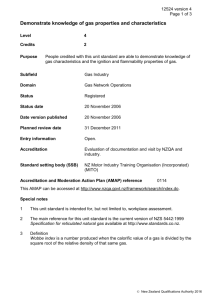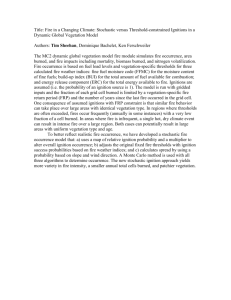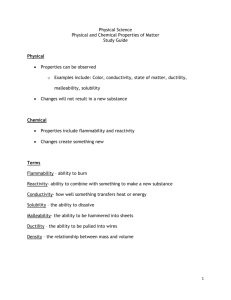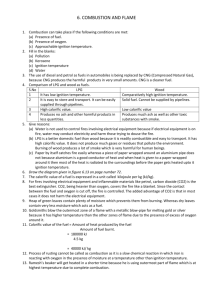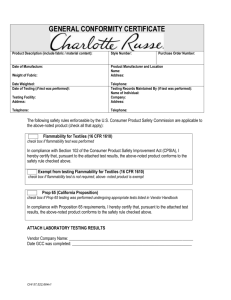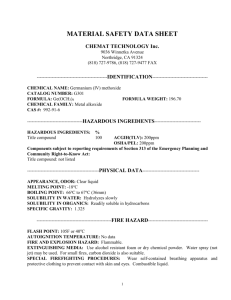2. – material and methods – main results
advertisement
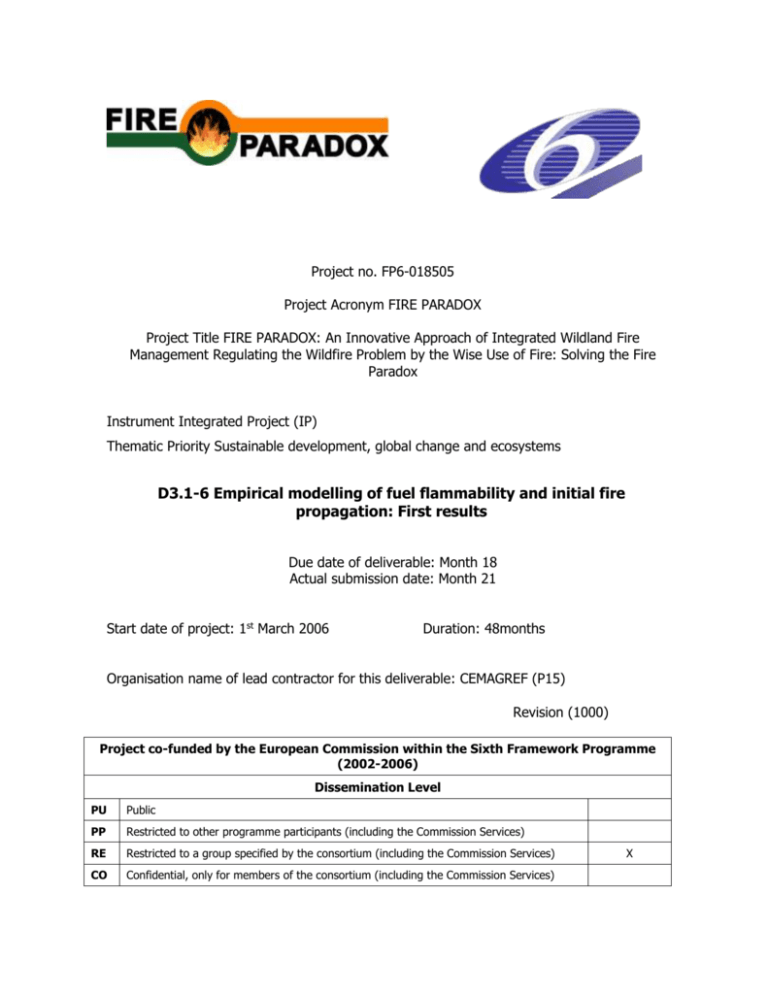
Project no. FP6-018505 Project Acronym FIRE PARADOX Project Title FIRE PARADOX: An Innovative Approach of Integrated Wildland Fire Management Regulating the Wildfire Problem by the Wise Use of Fire: Solving the Fire Paradox Instrument Integrated Project (IP) Thematic Priority Sustainable development, global change and ecosystems D3.1-6 Empirical modelling of fuel flammability and initial fire propagation: First results Due date of deliverable: Month 18 Actual submission date: Month 21 Start date of project: 1st March 2006 Duration: 48months Organisation name of lead contractor for this deliverable: CEMAGREF (P15) Revision (1000) Project co-funded by the European Commission within the Sixth Framework Programme (2002-2006) Dissemination Level PU Public PP Restricted to other programme participants (including the Commission Services) RE Restricted to a group specified by the consortium (including the Commission Services) CO Confidential, only for members of the consortium (including the Commission Services) X Participants: P15 (CEMAGREF), P07 (INIA-CIFOR) Curt T., Ganteaume A., Jappiot M., Lampin C., Borgniet L., Baudel, J., Esteve R., Martin W., N’Diaye Boubacar A. (P15, CEMAGREF) Madrigal J., Díez Galilea C., Marino E., Guijarro M., Hernando C. (P07, INIA) TABLE OF CONTENTS: 1. - INTRODUCTION ................................................................................................. 3 2. – MATERIAL AND METHODS – MAIN RESULTS ..................................................... 3 2.1. – FIELD SURVEY AND FLAMMABILITY EXPERIMENTS IN ACIDIC SOILS IN PROVENCE (CEMAGREF)... 4 2.1.1. – Sampling schedule and plot selection.............................................................. 4 2.1.2. – Field data, dead fuel collection ....................................................................... 5 2.1.3. – Flammability experiments .............................................................................. 5 2.1.4. – First results .................................................................................................. 7 2.2. – FIELD SURVEY AND FLAMMABILITY EXPERIMENTS IN CALCAREOUS SOILS IN PROVENCE (CEMAGREF) ................................................................................................................ 8 2.2.1. – Sampling schedule and plot selection.............................................................. 8 2.2.2. – Field data, dead fuel collection ....................................................................... 9 2.2.3. – Flammability experiments .............................................................................. 9 2.2.4. – Main results................................................................................................ 10 2.3. – FIELD SURVEY AND FLAMMABILITY EXPERIMENTS AT ROAD-WOODLAND INTERFACES IN PROVENCE (CEMAGREF) .............................................................................................................. 10 2.3.1. – Sampling schedule and plot selection............................................................ 11 2.3.2. – Field data, dead fuel collection ..................................................................... 12 2.3.3. – Flammability experiments ............................................................................ 12 2.3.4. – First results ................................................................................................ 13 2.4. – FLAMMABILITY EXPERIMENTS IN SHRUBLAND COMMUNITIES TREATED FOR WILDFIRE HAZARD REDUCTION IN GALICIA (INIA-CIFOR) ............................................................................... 15 2.4.1. – Field data, dead fuel collection ..................................................................... 15 2.4.2. – Flammability experiments ............................................................................ 16 2.4.3. – First results ................................................................................................ 18 3. – PRESENT STATE: ADVANCES AND PROBLEMS ................................................. 21 4. – PERSPECTIVES FOR THE NEXT PERIOD .......................................................... 22 5. – REFERENCES ................................................................................................... 23 D3.1-6-18-1000-1 Page 2 of 23 1. - INTRODUCTION Fuel flammability, that is “the relative ease with which a substance ignites and sustains combustion” (according to the Wildland Fire Management Terminology, FAO 1986) is closely related to the initial phase of fire propagation. Therefore, is an essential component of fuel hazard and fire risk assessment, that are relevant parts of fire management planning (Dimitrakopoulos 2001). In this frame, the objective of Activity 3.1.5 of FIRE PARADOX is to construct empirical models linking fuel bed flammability to stand and fuel characteristics. Two FP Partners are involved in this activity: P07 (INIA-CIFOR) and P15 (CEMAGREF) that have worked on different European ecosystems. CEMAGREF has sampled fuel beds in relation to fuel models that were studied within WP3.4, and has assessed the effect of variables related to fuel beds, stand characteristics, type of ignition source and wind speed on flammability parameters. Flammability experiments were conducted on fuel beds collected in three major ecosystems or environments that are typical of the French Mediterranean area of Provence: the forest ecosystems and fuel types on acidic (Maures area) and calcareous soils, and the road-forest interfaces (Calcareous Provence area). INIA-CIFOR has conducted flammability tests on fine dead fuel beds resulting of mechanical treatments for wildfire hazard reduction in shrublands, assessing the effect of variables related to fuel beds, types of treatment and types of ignition source/wind speed on flammability parameters. Fuel beds were collected in shrubland experimental plots located in Galicia (NW of Spain) where two types of treatments for wildfire hazard reduction, brush out and crushing, were carried out by Partner P10 (XG-CIFAL). This deliverable presents the first results of the conducted studies. 2. – MATERIAL AND METHODS – MAIN RESULTS Flammability tests were conducted on the collected fuel beds under laboratory conditions, with a point-source ignition. In order to ensure that the ignition of the fuel bed occurred under similar conditions allowing comparisons to previous experiments of both CEMAGREF and INIA-CIFOR, standardized cubes (2x2x1 cm) of Pinus sylvestris wood were used (Guijarro et al. 2002). These cubes (FMC = 12%), were ignited by mean of an electric radiator (Standard NF P 92-509-1985). To take into account the specific features of the studied fuel beds, methods differed slightly between the cases, as described below. D3.1-6-18-1000-1 Page 3 of 23 2.1. – Field survey and flammability experiments in acidic soils in Provence (CEMAGREF) 2.1.1. – Sampling schedule and plot selection The sampling schedule included the major fuel types described by CEMAGREF (Chandioux in Alexandrian et al. 2006): maquis, mixed maquis-Quercus suber woodlands, and Quercus suber woodlands (Figure1). These fuel types also correspond to a gradient of post-fire succession: low and open maquis dominated by Cistus species, medium and high maquis dominated by Erica sp. and Calycotome sp., mixed maquis - Quercus suber, and Quercus suber woodlands. This is coherent with the investigation of WP3.3 on fuel dynamics and postfire fuel succession, and WP3.4 on fuel characterization. Figure 1. Examples of fuel types investigated in the Maures area (maquis, Quercus suber woodlands and mixings) Plot selection was achieved through GIS mapping of the main fires listed since 1959 (Figure 2). Each fuel type was replicated at least five times. Plots were chosen in homogeneous site conditions, corresponding to the medium fertility class (Ladier & Ripert 1993) to prevent any difference of litter biomass due to site fertility. We located each corner and the centre of 20x20m plots with a GPS. We proceeded to an exhaustive vegetation and site description (composition, location of trees, coverage by successive vertical layers, a.s.o.) as described in WP3.3 and WP3.4. D3.1-6-18-1000-1 Page 4 of 23 Figure 2. Map of fire recurrence in the Maures massif (Provence, France), from the Agriculture and Forest Office 2.1.2. – Field data, dead fuel collection Within each plot, we described the spatial pattern of litter along a 2x2 m grid. On each point of the grid, we assessed the litter cover (visual estimation, %), and litter depth (three measurements per 1 m² using a metallic ruler, mm). Three samples per plot were collected, corresponding to the mean litter cover and depth, and to the minimum and maximum values. Previous experiments had stated that modifying litter structure can clearly change the flammability variables such as time to ignition or ignition frequency (unpublished results). So we decided to collect undisturbed litter samples using a metallic 40x40 cm plate pushed under the litter and a metallic circle (diameter 38 cm) to cut and collect the litter from above. All samples were numbered and cautiously put into a 40x40 cm cardboard box to prevent any damage to the litter. For the burning experiments, samples were cautiously extracted from the boxes and placed on the burning apparatus. 2.1.3. – Flammability experiments In a first step, the experimental plan comprised flammability tests in severe conditions occurring during the driest period of summer. All samples were oven-dried during two days at 60°C in a ventilated oven, to mimic severe drought and to get an ‘anhydrous’ state. In these experiments, ignition source (“standardized cube”) was used on the glowing state, i.e. each cube was put on the electric radiator until the beginning of flaming, and then we waited for the complete extinction of flames (= glowing) to pick up the cube and put it in the middle of the litter sample. We used one wind speed of about 10 km/h (ca. 3 m.s-1), which is considered ‘strong’. Wind was produced using a domestic dryer with hot air, and wind speed was assessed using an anemometer (accuracy 0.1 km.h-1). Wind direction was oblique (angle about 45°). To prevent any problem of heterogeneity among the flammability experiments, we measured the temperature and humidity of the air at the immediate vicinity of the burning apparatus D3.1-6-18-1000-1 Page 5 of 23 during all the experiments. These data will be used as covariates during data analysis, to assess if they had any influence on flammability. Flammability tests were operated in a ventilated room, at the INRA Avignon facility (Les Vignères) by courtesy of INRA (Figure 3). The burning apparatus was a metallic circle (diameter 38 cm), in which the undisturbed litter samples were put. The bottom of the apparatus was made of Siporex™ material, which is hypothesized to be ‘thermally neutral’. The whole apparatus, including litter, was placed on a scale (accuracy 0.1 g). Figure 3. Experimental apparatus for the flammability experiments (INRA Avignon-Les Vignères facility). See also e-observatory (www.eufirelab.org.) Different flammability variables were assessed: - Time to ignition (time between the dropping of the cube and the eventual beginning of litter flaming, in seconds) - Flaming duration (time with visible flames, in seconds) - Number of sides reached by fire (on the left, right, forward and backward direction) and time to reach the borders of the circle (in seconds) - Flame height (measured on 4 images per second, in cm) - Temperature during burning (two thermocouples were placed in the centre of the apparatus, at 20 and 40 cm above samples, in degrees Celsius) - Rate of burned biomass (using the mass loss during the burning, in g) - Rate of burned litter (visual estimation, %) D3.1-6-18-1000-1 Page 6 of 23 - Air temperature and humidity (covariates assumed to have a null effect) From these variables, we derived some secondary variables: - We estimated a ‘rate of spread’ in the fourth directions using the distance covered by flames and the time spent to reach each corner (RoS, in cm.s-1) - We computed the ignition frequency as the ratio between the number of trials for one litter type and the number of successful ignitions (in %). Ignition was considered successful when flame appeared during the experiment and was maintained for at least five seconds. The experiment on flaming duration lasts until the whole sample has burned or until the flames go out before the total burning of the sample. This flaming duration is more or les long (sometimes more than 5 minutes), depending on the tested variables (vegetation types, FMC, etc.). The experiments are never interrupted during the flaming process. 2.1.4. – First results The first results show that flammability variables are more explained by litter biomass than by vegetation facies, since vegetation is a continuum from open maquis (i.e. sclerophyllous matorrals dominated by Cistus sp., Erica sp. and Calycotome sp.) to Quercus suber woodlands. As a consequence, most litters are mixtures of Quercus leaves and dead twigs of understorey shrubs. In contrast, litter biomass varied strongly according to stand density and to stand successional stage: submature and mature Quercus suber stands cast shade on understorey shrubs, which senesce and produce a large amount of dead fuel (Table 1). Table 1. First results on flammability variables. NS = non significant; *= P-value<0.05; **=P- Ignition probability Vegetation Facies Biomass * ** Time to ignition (s) Flaming Duration (s) NS NS *** ** RoS (cm/s) Flame Height (cm) % biomass consumed ** ** **** *** ** **** Temperature emitted (°C) *** *** value<0.01; ***=P-value<0.001; ****=P-value<0.0001. Most flammability variables do not vary significantly among stands as shown in Table 2. D3.1-6-18-1000-1 Page 7 of 23 Table 2. Values of the main flammability variables according to the type of fuels Fuel Type Time to ignition (s) Flaming Duration (s) Flame Height (cm) Consumed Biomass (%) Mean Temperature (°C) Rate of Spread (cm.s-1) Dense Quercus suber woodland 26.2 ± 5 152 ± 17 15 ± 2 65 ± 5 a 40 ± 3 4.4 ± 1 Clear Quercus suber woodland 32 ± 5 117 ± 17 18 ± 2 79 ± 5 b 45 ± 3 3.8 ± 0.6 Maquis+Quercus (medium height) 36 ± 10 214 ± 31 17 ± 3,2 69 ± 9 ab 40 ± 5 3.5 ± 1.1 Maquis (medium height) 35 ± 11 151 ± 36 14 ± 4 55 ± 10 a 38 ± 6 2.6 ± 1.2 High maquis 41 ± 7 111 ± 22 18 ± 2 85 ± 7 b 41 ± 4 0.7 ± 3 F_ratio 0.77 2.4 0.49 2.6 0.73 0.41 P_value 0.5473 0.0568 0.7431 0.0425 0.5752 0.7973 In total, flammability is minimal for young maquis and mature cork oak stands that produce low amount of debris, medium for submature maquis, and high for mature maquis (high and closed) and mixed stands that produce large amounts of dead and highly flammable materials. 2.2. – Field survey and flammability experiments in calcareous soils in Provence (CEMAGREF) 2.2.1. – Sampling schedule and plot selection In this study, we investigated the flammability of complex litters belonging to five major wildland fuel models of calcareous Provence area described by CEMAGREF (Chandioux et al. 2006, Lampin et al. 2004) (Figure 4): Pinus halepensis stands, oak stands (Quercus pubescens or Q. ilex), mixed stands of pines and oaks, shrub-cleared Pinus halepensis stands, and matorrals dominated by Quercus coccifera. D3.1-6-18-1000-1 Page 8 of 23 Figure 4. Representative images of the five fuel types investigated in calcareous Provence (France). 1:Pinus halepensis stands; 2: Oak stands (Quercus pubescens or Q. ilex); 3: Mixed stands of pines and oaks; 4: Shrub-cleared Pinus halepensis stands; 5: Matorrals dominated by Quercus coccifera 2.2.2. – Field data, dead fuel collection Within each stand, litter was described on a line transect of 20 m. Every two metres, 10 points were sampled, alternatively on the right and on the left of the line, using a 1x1 m quadrat. For each square metre, a detailed description of the first two strata reported the shrub and herbaceous height, their coverage and the main species, the litter coverage, its composition and depth. In the middle of each square metre, one sample of litter was collected with a 20 cm diameter metal cylinder. The organic material from all 10 locations was mixed, the weight range varying from 113 g to 675 g. A 50 g sample for each of the 133 stands was then used for flammability experiments 2.2.3. – Flammability experiments These experiments were conducted following the methodology described in 2.1.3. All samples were oven-dried during two days at 60°C in a ventilated oven, to mimic severe summer conditions and to get an ‘anhydrous’ state. Each litter facies was replicated 19 to 30 times to ensure the repeatability of the flammability experiments, and the robustness of the predictive models. D3.1-6-18-1000-1 Page 9 of 23 2.2.4. – Main results The flammability experiments show clear differences among the studied litters (Table3). Table 3. Flammability variables for the five litter facies (Provence, calcareous soils) Fuel type Pinus Pinus-Quercus Quercus Pinus shrub-cleared Garrigue F-ratio, P-value Kruskal-Wallis test Fuel type Pinus Pinus-Quercus Quercus Pinus shrub-cleared Garrigue F-ratio, P-value Kruskal-Wallis test Sample Size 28 26 26 30 19 129 Time to ignition (s) 28 4 a 25 5 a 39 11 a 82 19 b 43 13 a 10.26 * Residence time (s) 268 31 b 266 39 b 156 31 a 150 34 a 101 25 a 30.76 **** Ignition frequency (%) 100 0.0 c 99 1.0 c 97 1.0 c 79 6.0 b 58 10.0 a 40.49 **** ‘Propagation’ (n sides reached) 3.3 0.3 b 3.5 0.2 b 3.2 0.3 b 1.6 0.3 a 1.3 0.3 a 34.04 **** Rate of spread (cm.s-1) 10.1 1.0 c 10.7 1.0 c 7.8 0.9 bc 6.5 1.4 ab 4.2 1.1 a 21.60 *** Area burned (%) 81.6 5.9 b 86.4 3.6 b 80.8 6.0 b 45.7 8.3 a 32.9 8.9 a 22.37 *** Flame height (cm) 22 2 c 20 2 bc 28 3 d 15 3 b 72a 32.76 **** Fuel consumption (%) 66.9 4.9 a 68.2 3.4 a 62.4 4.6 a 46.6 7.1 b 57.7 8.6 ab 2.48 * 2.3. – Field survey and flammability experiments at road-woodland interfaces in Provence (CEMAGREF) Litter and fuels on road-woodland interfaces (including forests and matorrals) exhibit specific features that may influence ignition hazard and thus require specific sampling methods and flammability experiments: - They are often made of mixtures between dead fuels (litter) and live fuels (herbaceous). Herbaceous species are often favoured by high radiation at the vicinity of roads, or invade from surrounding fields, or are sowed in order to prevent soil erosion. Herbaceous species can strongly vary according to site conditions, neighbouring vegetation or season. Likewise, herbaceous FMC strongly varies according to season and time of the day: in particular, herbaceous flammability is hypothesized to vary with phenology (namely the percent curing). - These mixtures are generally very spatially heterogeneous at small scale (< 1 m²) owing to intrinsic vegetation patterns or microsite conditions (e.g. bare soil outcrops). The intrinsic spatial variability of fuel (biomass, composition, bulk density) may strongly affect the ignition potential and flammability. D3.1-6-18-1000-1 Page 10 of 23 - Vegetation on road-forest interfaces is often modified by treatments such as herbaceous mowing and shrub-clearing, which are intended to improve visibility and to limit fire propagation and intensity along the roads. The flammability of mixtures is hypothesized to strongly vary according to these treatments. 2.3.1. – Sampling schedule and plot selection Sampling and plot selection took into account the specific features detailed above. We first investigated the variability of vegetation types along road-forest interfaces, focusing on byways and state ways. Five representative vegetation types were selected: herbaceous (dicots), herbaceous (graminae), pure litter (Pinus halepensis), mixing #1: litter+graminae, mixing #2: litter+graminae+shrubs (Quercus coccifera). Except for the pure litter dead fuel, we selected plots having both the unmanaged vegetation and a managed facies, mowed or shrub-cleared (Table 4). Table 4. Sample plan (First results) Low Wind' (3.2 km/h) Ignition Mode Glowing Cube Flaming Cube FMC Values Fresh EMC room Anhydrous (oven-dried) Fresh EMC room Anhydrous (oven-dried) Total Batch Control (= unmanaged) A B C D G 10 10 10 10 10 10 10 10 10 10 10 10 10 10 10 10 6 10 10 10 11 4 8 10 10 41 40 48 50 60 E 9 7 10 10 36 Mowed / shrub cleared F H I J K 10 10 6 10 10 10 10 10 10 10 10 10 10 10 10 9 10 10 10 10 10 10 10 10 9 10 10 10 10 7 59 60 56 60 56 Total L 10 10 10 10 10 10 60 Strong Wind' (9.7 km/h) Glowing Cube FMC Values Fresh EMC room Anhydrous (oven-dried) Total D3.1-6-18-1000-1 Batch Control (= unmanaged) M P R T 10 10 10 10 10 10 10 10 10 10 10 10 30 30 30 30 Mowed / shrub cleared Total N O Q S U 10 10 10 10 10 90 10 10 10 10 10 90 10 10 10 10 10 90 30 30 30 30 30 270 Page 11 of 23 115 117 120 69 105 100 626 2.3.2. – Field data, dead fuel collection Samples were collected avoiding disturbance, to take into account the real fuel structure. This is especially important for herbaceous-shrub-litter mixtures, which are very heterogeneous and this could affect flammability as indicated above (2.1.2). As the sampling plan comprised a huge amount of burning experiments, we collected small (20x20 cm) undisturbed samples. We used a metallic 20x20 cm template to delimit each sample, and a solid 20 cm large trowel to extract the whole sample. Each sample was numbered and directly put into an aluminium tub to prevent any damage. Samples have been burned in this tub. 2.3.3. – Flammability experiments The schedule for flammability experiments comprised: - Five vegetation types (presented above) - Two management modes: unmanaged vegetation and mowed/shrub-cleared facies - Two ignition modes: the standardized cube was used at the glowing stage (see above) or at the flaming stage. In the latter case, the cube was ignited with the epiradiator then put in the sample 45 seconds after ignition, that is to say flaming - A wide range of FMC values: real values from the field (= fresh) obtained by periodic collection along the summer season, EMC values obtained after indoor equilibrium during 2days had been attained, and anhydrous values obtained by oven-drying during 2 days at 60°C - Two wind speeds: ‘low wind’ (ca. 3 km.h-1 ~ 1 m.s-1) and ‘strong wind’ (ca. 10 km.h-1 ~ 2.9m.s-1) Each of these modalities (i.e. one vegetation facies X one management mode X one FMC value X one wind speed) was replicated 20 to 30 times. Experiments were conducted at CEMAGREF Aix-en-Provence. As the main objective was to assess the ignition frequency on a large number of replicates, we assessed only: - Time to ignition (time between the dropping of the cube and the eventual beginning of litter flaming, in seconds) - Flaming duration (time with visible flames, in seconds) - Number of sides reached by fire (on the left, right, forward and backward direction) - Air temperature and humidity (covariates assumed to have a nil effect) D3.1-6-18-1000-1 Page 12 of 23 The ignition frequency was computed as the ratio between the number of trials for one litter type and the number of successful ignitions (in %). Ignition was considered successful when flame appeared during the experiment and was maintained during at least ten seconds. The experiment on flaming duration lasts until the whole sample has burned or until the flames go out before the total burning of the sample. This flaming duration is more or les long (sometimes more than 5 minutes), depending on the tested variables (vegetation types, FMC, etc.). The experiments are never interrupted during the flaming process. 2.3.4. – First results The first results show clear differences of flammability among the five studied vegetation facies (Curt et al, 2007). As shown in Table 5, ignitability1 is a combination of almost all variables, while sustainability2 and initial propagation mostly depend on the specific characteristics of dead fuels. Vegetation facies and wind speed are explicative factors for all the flammability characteristics measured. Figure 5 indicates that three major groups of vegetation can be distinguished according to their flammability parameters: - Group 1 (herbaceous) is characterized by short ignition delay and short duration of ignition, propagation to all sides. This means a high ignitability and initial propagation but low sustainability; - Group 2 (litter) has a long ignition delay and long flaming duration, but propagation to half of the sides. In comparison with the other studied vegetation facies, pine litter has a low ignitability but a high sustainability; - Group 3 (mixed) has an intermediate behaviour. The presence of dead shrubs tends to decrease ignitability and the initial propagation. 1 2 The amount of time until ignition once a material is exposed to a known ignition source (Martin et al. 1994) The amount of time that a material will combust with or without a constant ignition source (Martin et al. 1994) D3.1-6-18-1000-1 Page 13 of 23 Table 5. Effect of the main causal variables on the vegetation flammability Factors Flammability Variables Vegetation Type Mode of Ignition Wind Speed Vegetation Management FMC Probability of Ignition 48.5 **** 559.8 **** 164.5 **** 8.1 ** 16.2 *** Time to Ignition (s) Flaming Duration (s) Number of sides burnt (n) 5.2 *** 1.0 NS 28.6 **** 1.9 23.9 *** 342.9 **** 109.2 **** 3.36 11.0 **** 493.2 **** 170.3 **** 0.8 NS NS NS 2.7 NS 17.7 **** 24.1**** Flaming Duration (s) Time To Ignition (s) A General linear model procedure (GLM) shows that the probability of ignition and time to ignition result from a combination of all variables studied except for vegetation management (Table 5). The flame sustainability (i.e. flaming duration) and its initial propagation (i.e. number of sides burnt) have similar causes. Overall, the vegetation type and the wind speed are the two factors that play a role on all flammability variables. 50 1 2 3 40 30 20 F=2.99 p=0.01 10 0 100 HG HS L HG HS L 80 LH LLH F=14.86 p <0.0001 60 40 20 Nr. Sides Reached 0 LH F=31.68 LLH p<0.0001 4 3 2 1 0 HG HS L LH LLH Figure 5. Presentation of the three major groups of vegetation. HG = dicot grasses; HS = graminae grasses; L = pine litter; LH = pine litter + graminae grasses; LLH = pine litter + graminae grasses+ shrubs (predominance of Quercus coccifera). D3.1-6-18-1000-1 Page 14 of 23 2.4. – Flammability experiments in shrubland communities treated for wildfire hazard reduction in Galicia (INIA-CIFOR) Over 14000 wildfires happen every year in Galicia (NW of Spain) and more than 80% of them in shrubland areas (Vega et al. 1998) where different shrub communities (gorse, winged broom, heather, etc.) are widespread. Therefore, it is necessary to apply fuel reduction treatments in order to reduce the risk, extent and severity of wildfires, particularly in the wildland urban interfaces. In this frame, the objective of the present work is to determine the effect of treatments for fuel reduction on ignition hazard, assessing the flammability of the fuel beds resulting of these treatments. 2.4.1. – Field data, dead fuel collection An experimental site was set up by XG-CIFAL in a representative shrubland community of Galicia, consisting of Ulex sp., Erica sp. and Chamaespartium sp., where two types of mechanical treatment for wildfire hazard reduction (crushing and brush out) were conducted (Figure6). Four months after the treatments, resulting fine dead fuels were collected, separated by strata, and send to the INIA-CIFOR Laboratory. 1 2 3 4 Figure 6. Plots of mechanical treatments for wildfire hazard reduction: 1: General view of the treatment area; 2: Detail of vegetation before treatments; 3: Detail of a crushing plot; 4: Detail of a brush out plot D3.1-6-18-1000-1 Page 15 of 23 2.4.2. – Flammability experiments In a first phase, a set of 46 preliminary flammability tests with a point-ignition source was conducted in an indoors fire bench and in an outdoors wind tunnel, on the fine dead fuels resulting of the mechanical treatments. Selected variables were: treatment for wildfire hazard reduction, wind speed and type of ignition source. Fuel characteristics (fuel moisture content, fuel load, thickness, high calorific value) were determined. Following the analysis of the results of these preliminary tests, the experimental device and protocol were defined as described below. The experimental device (Figure 7) consists of: An aluminium tray, on which the fuel bed (18 x 11.5 cm) is placed. A calorific focus (electric radiator) on which the ignition source (the standardised wood cube described above) is placed to produce ignition (Figure 7.1). A domestic dryer with hot air that provides an oblique (angle about 45°) air flow of 0.8 m.s-1 to the tray holding the fuel bed (Figure 7.2). Wind speed was assessed using an anemometer (accuracy 0.1 m.s-1). 1 2 Figure 7. Experimental device for the flammability experiments (INIA-CIFOR): 1:Calorific focus and aluminium tray; 2: General view. Flammability experiments were carried out reconstructing the fuel beds according to their structure and average fuel load, obtained in field inventories conducted by XG-CIFAL (Table 6). D3.1-6-18-1000-1 Page 16 of 23 Table 6. Minimum, mean and maximum values of fuel load (g.m2-1), of each treatment and stratum. 1: Upper stratum: for crushing = L layer; for brush out = residues layer. 2: Lower stratum: for crushing = F+H layer; for brush out = L+F+H layer Treatment Crushing Brush out Minimum 599 53 Upper stratum1 Mean Maximum 1029 1485 87 127 Minimum 1834 2076 Lower stratum2 Mean Maximum 2701 3578 2576 3253 The schedule for the flammability tests comprised: - Two types of shrub treatment: crushing and brush out. - Two ignition modes: the standardized cube was used while in flames and without air flow, and at the glowing stage and a 0.8 m.s-1 air flow. - Two levels of FMC: EMC values gained by chamber equilibrium at 23C and 50%, and anhydrous values obtained by oven-drying during two days at 60C. Each of these modalities (i.e. one type of shrub treatment X one ignition mode X one FMC level) was replicated at least ten times. Several flammability parameters were assessed: - Time to ignition (time between the dropping of the cube and the eventual beginning of fuel bed flaming, in seconds). - Flaming duration (time with visible flames, in seconds). - Number of sides reached by fire (on the left, right, forward and backward direction) and time to reach the borders of the tray (in seconds). - Rate of burned biomass (using the mass loss during the burning, %). - Ignition frequency (ratio between the number of trials for each modality and the number of successful ignition, in %. Ignition was considered successful when a flame appeared during the experiments and maintained during at least ten seconds). - Propagation frequency (ratio between the number of trials for each modality and the number of successful propagation, in %. Propagation was considered successful when combustion, with or without flame, reached at least two sides of the tray). The experiment on flaming duration lasts until the whole sample has burned or until the flames go out before the total burning of the sample. This flaming duration is more or les long (sometimes more than 5 minutes), depending on the tested variables (vegetation types, FMC, etc.). The experiments are never interrupted during the flaming process. D3.1-6-18-1000-1 Page 17 of 23 2.4.3. – First results ANOVA analysis As shown in Table 7, ignition frequency depended on FMC and treatment, while the time to ignition was significantly affected by ignition mode. Sustainability and initial propagation depended on the three factors considered: ignition mode, FMC and treatment (1 = crushing, 2 = brushing out). First results of ANOVA show that both the type of mechanical treatment for wildfire hazard reduction and FMC significantly affected ignition frequency, flaming duration, number of sides reached and rate of burned biomass. Otherwise, the ignition mode did not affect significantly ignition frequency, but strongly affected the others flammability variables. Table 7. ANOVA shows the effect of the main flammability variables on the three selected factors: ignition mode, fuel moisture content (FMC) and fine dead fuels resulting of the treatments. NS = non significant; *= P-value<0.1; **=P-value<0.05; ***=P-value<0.01; ****=P-value<0.001. Flammability Variables Ignition Frequency Ignition mode FMC Treatment NS * * **** ** *** **** NS NS * ** * **** * ** Ignitability Time to ignition Flaming Duration Sustainability Nr. sides reached and initial propagation Rate of burned biomass Preliminary Logistic Models Preliminary models to predict the ignition frequency and the probability of propagation have been developed. Classification of observations was modelled with logistic regression. The logistic models are of the form of Eq. (1) where P is the probability of the event modelled that is bound between 1 (ignition or propagation) and 0 (no ignition or no propagation), “a” the intercept term, ΣbiXi the linear combination of parameters bi and independent variables Xi and e is the base of natural logarithm. P=(1+e-(a+ ΣbiXi))-1 (1) The preliminary models have been fitted selecting three independent variables according to the experiment design: Ignition mode (binary variable), FMC (continuous variable) and treatment (binary variable). The graphical representation (Figure 8) of the two models shows the significant difference of the curves. Goodness of fit tests and area under the Receiver D3.1-6-18-1000-1 Page 18 of 23 Operating Characteristic (ROC) curve, interpreted as a measure of the accuracy of the models, indicates a good fit in all cases. Some preliminary conclusions concerning the ignitability of the fuel beds resulting of the two mechanical treatments for wildfire hazard reduction can be deduced from the logistic model developed for the “ignition frequency” (Figure 8). Firstly, this model indicates the higher ignition probability of the fuel bed resulting of treatment 1 (crushing) for both ignition modes. The main reason is the higher values of fuel load of the upper stratum resulting of treatment 1 compared with treatment 2 (brush out) (Table 6). Secondly, the ignition mode 1 (flame state) had a significant positive influence on the ignition frequency for both treatments. Finally, for both treatments and ignition modes, the model shows that the smallest the FMC, the highest the ignition probability. Probability Probability of ignition 1 0,9 0,8 0,7 0,6 0,5 0,4 0,3 0,2 0,1 0 Treatment 1, Ignition mode 1 Treatment 1, Ignition mode 2 Treatment 2, Ignition mode 1 Treatment 2, Ignition mode 2 Ignition (Observed values) n=83 2 3 4 5 6 7 8 FMC (%) 9 Wald Test (p-value) Area under ROC curve p=0.0017 c=0.78 -2LL 86.93 2 χ Percent correct (cut off=0.6) 22.76 70 % 10 11 Probability Probability of propagation 1 0,9 0,8 0,7 0,6 0,5 0,4 0,3 0,2 0,1 0 Treatment 1, Ignition mode 1 Treatment 1, Ignition mode 2 Treatment 2, Ignition mode 1 Treatment 2, Ignition mode 2 Propagation (Observed values) n=83 Wald Test (p-value) p=0.0004 2 3 4 5 6 7 8 FMC (%) 9 Area under ROC curve c=0.85 -2LL χ2 80.92 34.12 Percent correct (cut off=0.55) 75 % 10 11 Figure 8. Graphic representation of logistic models (left) and ROC curves with goodness of fitted test (right). Sustainability and initial propagation have been evaluated through the logistic model developed for the “ignition frequency” (Figure 8). The graphical representation of predicted values shows a higher probability of propagation with the ignition mode 2 (glowing cube and air flow), this probability being higher for treatment 1 (crushing) than for treatment 2 (brush out). Although the ignition probability was higher with the ignition mode 1 than the ignition mode 2, the presence of burn without flame on several test of treatment 2 (brush out) and the action of the air flow (0.8 m.s-1) explain the positive effect of ignition mode 2 on D3.1-6-18-1000-1 Page 19 of 23 propagation. Finally, as it happens in the ignition frequency, the smallest is the FMC during the test, the highest is probability of propagation. Preliminary General Linear Models In order to assess sustainability during the initial propagation process and the effect of the three selected factors, a general linear model has been fitted. The descriptive dependent variable characterizing this process was the flaming duration. The independent variables selected were, according with the experiment design, ignition mode (binary variable), FMC (continuous variable) and treatment (binary variable). As shown Figure 9, results are consistent with preliminary logistic models. The adjusted R-squared indicates that the model explains 61.4% of the variability of the flaming duration. Flaming Duration 740 observed 540 FIGURA 9 CON EL GLM) (INCLUIR Flaming Duration = 317,21 + 107,15 * (Treat.= 1) + 67,15 * (Ignit.mode = 1) - 23,26 * FMC Adjusted R-Squared = 0,61 340 n = 51 Standard Error of Estimate (SEE) =107,938 140 Mean Absolute Error (MAE) = 82,7579 -60 -60 140 340 540 predicted Treatment: 1 = Crushing 2 = Brush out Ignition mode: 1 = flaming cube, 0 m/s 2 = glowing cube, 0.8 m/s 740 Figure 9. General linear model fitted to predict the flaming duration. On the left appears the observed versus predicted graphic; on the right, the equation fitted and the statistics. D3.1-6-18-1000-1 Page 20 of 23 3. – PRESENT STATE: ADVANCES AND PROBLEMS The work is on progress in agreement with the DoW plan. Concerning CEMAGREF, the sampling plan is complete for road-forest interfaces, but incomplete for fuels on acidic soils (Maures). A second period of field sampling and burning experiment has been held between May and July, 2007. We shall add about 80 samples to have a sufficient number of replicates per fuel type. Collecting undisturbed samples is scientifically valuable but very timeconsuming, and implies to take precaution during sampling, transportation and experimentation. The use of a thermal camera or computer-assisted thermocouples would allow gaining time. Concerning INIA-CIFOR, a second period of field sampling and burning experiments will be held between August 2007 and February 2008. D3.1-6-18-1000-1 Page 21 of 23 4. – PERSPECTIVES FOR THE NEXT PERIOD The perspectives for CEMAGREF are: - To complete the database on acidic soils (additive sampling), on calcareous soils (undisturbed samples) and for road-forest interfaces (additional FMC values in order to get FMC values ranging continuously from 3 to 40%, by moisturizing samples) - To develop empirical models linking dead fuel flammability to stand and fuel characteristics. The perspectives for INIA-CIFOR are: - To conduct laboratory tests to assess the effect of fuel load on flammability of the fuel beds resulting of crushing and brush out. - To conduct laboratory tests to assess the effect of the temporal variation of fuel following prescribed fire treatment to reduce hazardous fuel accumulation. - To conduct laboratory tests on untreated fuels to assess the effect of the treatments. Final results of this work will be presented within Deliverable D3.1-11, due in Month 46 of the Project. D3.1-6-18-1000-1 Page 22 of 23 5. – REFERENCES Alexandrian D., Jappiot M., Lampin C., Curt T., Long M., Chandioux O., Estève R. 2005. Cartographie de l’aléa feu de forêt sur le massif des Maures. Notice explicative, DDAF du Var. Chandioux O, Jappiot M, Lampin C, Curt T, Borgniet L, 2006. Towards Fuel models in calcareous south of France. In ‘Proceedings of the V International Conference on Forest Fire Research’. 27-30 November 2006. Luso (Portugal). Curt T., Ganteaume A., Alleaume S., Borgniet L., Jappiot M., Lampin C., Chandioux O., 2007. Vegetation flammability and ignition potential at road-forest interfaces (Southern France). In ‘Proceedings of the IV International Wildland Fire Conference’. 13-17 May 2007. Seville (Spain). Dimitrakopoulos A. 2001. A statistical classification of Mediterranean species based on their flammability components. International Journal of Wildland Fire, 10: 113-118. FAO, 1986. Wildland Fire Management Terminology. FAO Forestry Paper 70. Rome. Guijarro M., Hernando C., Díez C., Martínez E., Madrigal J., Lampin-Cabaret C., BlancL., Colin P.Y., Pérez-Gorostiaga P., Vega J.A., Fonturbel M.T. 2002. Flammability of some fuel beds common in the South-European ecosystems. In ‘Proceedings of the IV International Conference on Forest Fire Research’. 18-23 November 2002. Luso (Portugal). Jappiot M., Curt T., Lampin C., Borgniet L., Vinet O., Louis S., Chandioux O., Estève R. 2007. Characteristics and flammability in French Mediterranen litter fuels. In ‘Proceedings of the IV International Wildland Fire Conference’. 13-17 May 2007. Seville (Spain). Ladier J., Ripert C. 1993. Les stations forestières de la Provence cristalline (Cap Sicié, îles d’Hyères, Maures, Tanneron), Typologie des stations forestières, CEMAGREF Aix-enProvence. Lampin C., Chandioux O., Paulet V., Jappiot M., 2004, Typologie de la végétation combustible dans les interfaces agriculture forêt urbain, Conseil régional Rapport final. 116 p Martin R.E., Gordon D.A., Gutierrez M., Lee D., Molina D.M., Schroeder R.A., Sapsis D.B., Stephens S., 1994. Assessing the flammability of domestic and wildland vegetation. In ‘Proceedings of the 2nd International Fire and Forest Meteorology Conference’. Jeckyll Island, Georgia, USA, pp 130-137. Vega J.A., Cuiñas P., Fontúrbel T., Pérez-Gorostiaga P., and Fernández, C. 1998. Predicting fire behaviour in Galician (NW Spain) shrubland fuel complexes. In ‘Proceedings of the III International Conference on Forest Fire Research & 14th Conference on Fire and Forest Meteorology’, 16-20 November 1998. Luso (Portugal). Vol. I. pp 713-728. D3.1-6-18-1000-1 Page 23 of 23


